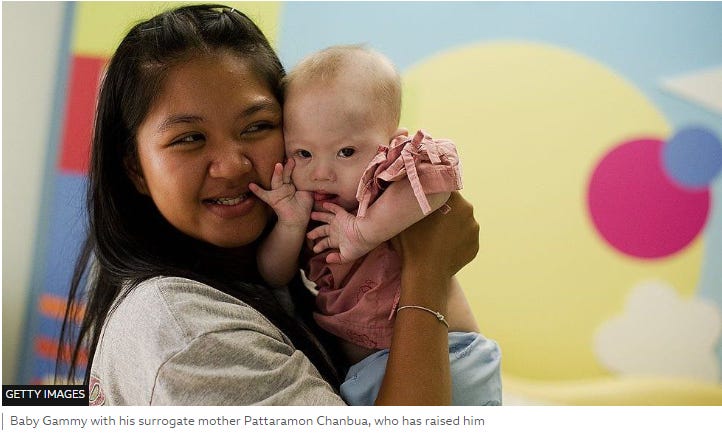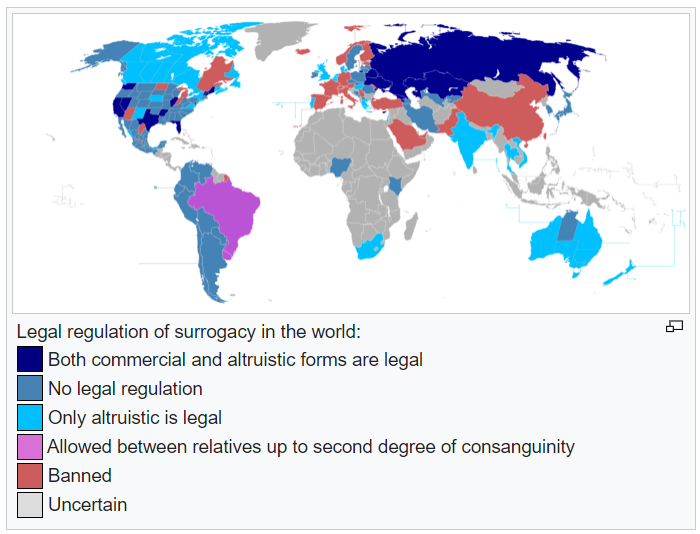Womb for Rent: The pitfalls of Surrogacy
How a noble cause was turned into a business where the commodities are babies.
The first time I ever heard about surrogacy was through a random trailer for a documentary on the industry of renting wombs for wealthy couples who could not get pregnant. I was probably a teenager at the time and I never got around to seeing the documentary but I remained intrigued by that practice.

Surrogacy is an arrangement, often supported by a legal agreement, whereby a woman agrees to deliver a baby for another person or couple. Surrogacy comes in two forms - gestational, where the surrogate mother is implanted with an egg and sperm of the commissioning parents; and traditional surrogacy, where the surrogate's own egg is used and fertilized through in-vitro.
Carrying another person’s baby is not a modern-day phenomenon, there are several historic written accounts documenting it, along with the struggles of infertility couples faced, in a society where a women’s value was largely connected to her ability to have children. Today, surrogacy has become increasingly common, with an estimated 5000 births in the U.S. alone.
The first legal and financially compensated surrogacy case in the United States happened in 1980 and ended with the birth mother changing her mind and keeping the child. Elizabeth Kane, a pseudonym, was an Illinois housewife who had given her first child up for adoption and wanted to help an infertile couple with the ultimate gift of life. Her egg was used in the conception of the child, so besides being the surrogate she was also the biological mother. She later admitted she was unprepared to deal with the emotional tsunami that ultimately made her decide to keep the child. The legal system was also unprepared to deal with these circumstances back then but still to this day, bizarre cases such as this continue to happen.
Just a few years after, around 1984 one of the most infamous surrogacy cases rose to the spotlight in the U.S., the Baby M. Case, happened in similar circumstances - the surrogate woman (also the biological mother since her own egg was used), changed her mind and decided she wanted to keep the baby. In the aftermath of this case, surrogacy was outlawed in New York, even though if only briefly.
Nowadays, New York has very few restrictions on surrogacy, giving primordial rights to the commissioning parents.
In Thailand, the case of baby Gammy shed new light on some of the tragic circumstances of this practice. In 2013, surrogate Pattaramon Chanbua gave birth to a boy, Gammy, and a girl, Pipah, conceived with the commissioning father’s sperm and donor eggs. The commissioning parents chose to leave Gammy, who had Down's syndrome, in Thailand, while taking his non-disabled twin sister Pipah home to Australia.
An Australian court later decided that the commissioning parent did not abandon the boy, with the judge declaring:
"Their ability to recall what happened, and in what order, has been impaired by the anxiety felt for the health of the babies, and by the tensions that arise when a woman's body is rented for the benefit of others and where the unit of exchange is measured in the life of a new human being."
The unit of exchange in these types of contracts is a baby.
The court noted that although the commissioning father, was a convicted sex offender, there was a "low risk of him abusing the girl", even though he had already been convicted of molesting two girls under the age of 10 in the late 1990’s.
In 2015, as a response to the rising cases of exploitation of vulnerable surrogate mothers, Thailand banned all surrogacy by foreigners. Under the new law, only married Thai couples or couples with one Thai partner who have been married for at least three years can seek surrogacy, and commercial surrogacy is strictly banned.
India followed suit shortly, effectively banning commercial surrogacy to stop the exploitation of vulnerable women. Commissioning parents were quick to change their destinations to Georgia instead, a European country where commercial surrogacy is still legal and cheap.
But it’s not just economically poor European or Asian countries that have been forced to deal with the pitfalls of rented wombs; the legal imbroglios are stretched out far across the world.
Adina Portaru, writing for Public Discourse, states that the “European Court of Human Rights (ECHR) has made some significant—and troubling—rulings relating to surrogacy. In the cases of Labassée v. France and Menesson v. France, the court compelled France to set aside its own public order, which defines a child’s mother as the woman who gave birth to the child. The decisions in some of these cases ignored the right of children, as set out in the UN Convention on the Rights of the Child, to know and grow up with their biological parents. There may be up to six persons claiming parental rights over a child born out of surrogacy agreements: the surrogate mother, the genetic mother (egg donor), the commissioning mother, the husband of the surrogate mother (presumption of paternity), the genetic father (sperm donor), and the commissioning father”.
Surrogacy seems to violate several international and European laws, like the Convention on the Rights of the Child (1989), and the United Nations Protocol on the Sale of Children (2000). Article 1 states “countries shall prohibit the sale of children, child prostitution, and child pornography as provided for by the present Protocol”.
Surrogacy when involving monetary compensation is a legal contract for an exchange of a product or service - a baby.
Article 2 of is perhaps the most clear, addressing that “the sale of children means any act or transaction whereby a child is transferred by any person or group of persons to another for remuneration or any other consideration”.
While it is clear that commercial surrogacy amounts to the sale of babies according to the United Nations Protocol, this organization has no enforcement capability, relying only on advising and creating protocol recommendations.
Surrogacy laws vary by country with most of Europe banning it while a few European countries allow only altruistic surrogacy where no monetary compensation is allowed.
The surrogacy industry is growing exponentially and expected to reach $27.5 billion by 2025.
Countries with uncertain or no legal regulation are hotspots of womb rentals where women are often impoverished and as such, turn to renting their wombs as a solution to provide for their families and themselves.
Before the Russian invasion, Ukraine was becoming one of the top destinations for intended parents to find a surrogate.
Being one of the poorest countries in Europe, young women turned to renting their wombs as an escape from very low salaries. A job in Ukraine can pay as little as $200 a month, but carrying someone else's baby could earn them up to $20,000. As long as commercial surrogacy remains an option for wealthy commissioning parents, disadvantaged women will continue to see it as an escape and the child’s interest will continue to be ignored.
In the United States, surrogacy varies according to each state. Lousiana, Nebraska, and Michigan do not allow any commercial surrogacy and therefore penalize any financial compensation, only allowing for couples to use their own gametes (eggs and sperm). The United States seems to be an outlier in the favorability its laws provide to commercial surrogacy, with the majority of states presenting few limitations on who can commission a child.
Commercial surrogacy has also become increasingly visible through celebrities that choose this path. Jamie Chung, an American actress, received some public backlash this year after she announced that she chose surrogacy to have her twin babies due to “career concerns” and fear that caring for a baby for two-plus years would damage her career. Something she was not willing to risk.
Infertility, a genuine medical condition, that gave rise to surrogacy seems to have been substituted in modern culture by the sheer inconvenience of becoming pregnant. She is not alone in choosing surrogacy over carrying her own baby, Kim Kardashian also had two children in the same manner and the list of celebrities doing so continues to grow. Babies and children need constant care, attention, and dedication, all of which appear to terrify a new generation of mothers that seek a shortcut to motherhood while eliminating the inconvenience of pregnancy from their lives.
As renting someone’s womb becomes increasingly ordinary, so does trivializing pregnancy and babies.
The serious and more obvious problem of surrogacy is that it constitutes an exploitation of the female body and her reproductive organs, there is no getting around this fact. I will concede rare cases of surrogacy when done by a family member because of infertility, which have valid reasons to occur and are not compensated monetarily. Those cases have their own special category.
As for commercial surrogacy, there is a strong case for following Europe’s example and outlawing all commercial surrogacy.
It is not just the exploitation of vulnerable women at stake but also the well-being of the child. The gestational connection that happens between mother and baby during pregnancy is meant to form a strong and lasting bond, which gets broken in this process. A study published in 2012 in the Journal of Child Psychology and Psychiatry found that the “absence of a gestational connection to the mother may be more problematic for children than the absence of a genetic link” with the child facing significant adjustment difficulties including depression. The bond created in pregnancy between mother and baby was shown to be of critical importance. Another small study, however, has found that around age 14, teenagers born through surrogacy did not differ psychologically from natural conception families, which suggests that perhaps the bumpy emotional years may smooth out over time.
There are also medical complications for surrogate women that can occur from the pregnancy, such as post-partum depression and recovering from c-sections, all of which the commissioning parents may not be willing to sustain once they have their baby in hands.
Jennifer Lahl of the Center for Bioethics and Culture Network shares that some surrogates that reach out to her feel like they are often disregarded after delivering the baby to the comissioning parents: “They feel as if they have been hired to do a job, and that job is a paid breeder. One surrogate, who almost died due to high-risk pregnancy complications, was told that it was her fault and was accused of doing it on purpose to make more money”.
The procedure is also medically risky for babies since babies conceived through in-vitro fertilization (which surrogacy procedures require) are at risk for premature birth, low birth weight, cerebral palsy and other problems.
Rejection due to imperfection is another consequence of commercial surrogacy, since intended parents are indeed paying for a previously agreed “product”, what happens when the baby does not meet their specifications? Comissioning parents have been known to abandon or reject the baby when it does not meet their demands.
Commercial surrogacy is not an act of kindness, the engine behind this billion-dollar industry is monetary and not altruistic. There is little consideration to the ethics of the procedure and to the well-being of the surrogate woman, who may be at a higher risk of long-term psychological damage. While some will scream from the mountaintop that there’s plenty of women who would carry someone else’s baby and not experience any emotional or psychological effects, the majority of women will tell you otherwise. The overwhelming majority of women could not imagine getting paid to carry a baby and then submit it to the commissioning parents after nine months of creating a bond with it in their belly.
In a study published in 2011 - Families created through surrogacy: Mother-child relationships and children’s psychological adjustment at age 7, the authors found that while there were no differences between surrogacy families or biological families (and in the early years the commissioning mother actually displayed greater joy and warmth when compared to biological families) when the child turned 7, some differences were indeed observed.
“There was a difference, however, between the surrogacy families and the natural conception families for the observational measure of mutuality, reflecting less positive mother-child interaction among the surrogacy than the natural conception mother-child dyads. The unexpected finding of significantly lower levels of mutuality in both the surrogacy and the egg donation families than in the natural conception families suggests that the absence of a biological link between the mother and her child may be associated with less positive mother-child interaction at age 7.”
Mutuality is distinct from maternal positivity and negativity in that it reflects reciprocal interaction between the mother and the child rather than the behavior of the mother or child alone. It also seems that the absence of a biological link between mothers and their children may be associated with more subtle differences in patterns of mother-child interaction, i.e. in relation to responsiveness, reciprocity, and cooperation.
In Iran, where surrogacy is actually permitted, a qualitative study from 2014, concluded that surrogate mothers experience significant emotional attachment to the baby and that “surrogacy pregnancy should be considered as a high-risk emotional experience because many surrogate mothers may face negative experiences.”
With so many issues already concerning the American public, there seems to be no room for now, to discuss the pitfalls of commercial surrogacy. If and when that time arrises, it’s important to separate altruistic familiar surrogacy from monetary surrogacy, the former has space to occur in a society that prioritizes women and children, the latter goes against basic morals and ethics of a principled society.







You have written a deep analysis on the concerning topic of surrogacy, Laura. I can't help but be reminded of something similar to this in "The Giver", a dystopian book by Lois Lowry. In the said book, if I remember it right, couples no longer bear children of their own. Child-bearing in that society had been delegated to a group of women known as Birthmothers. After being nurtured for a time, the babies are then assigned/placed to families that they will recognize as their own for life.